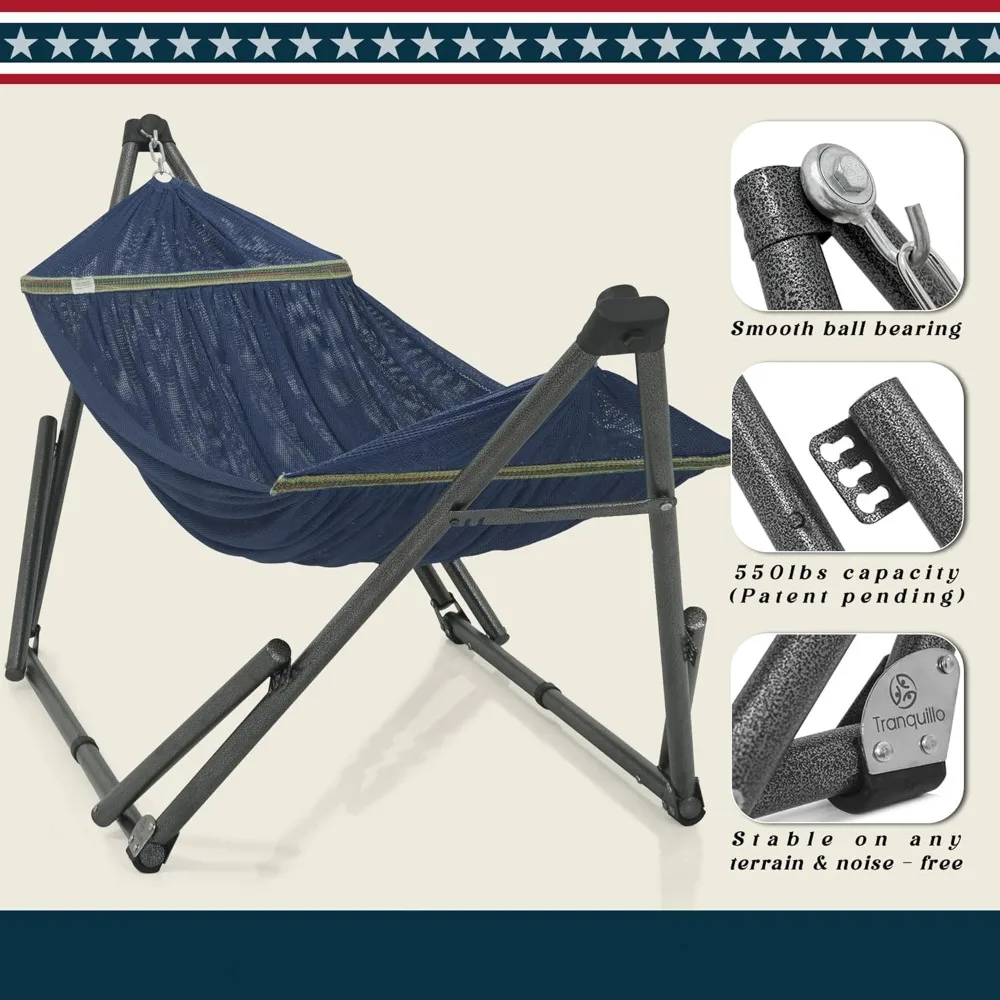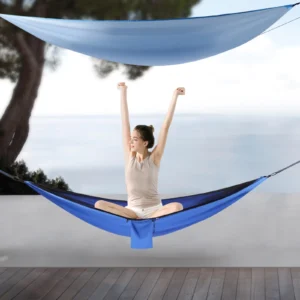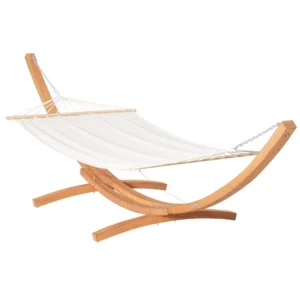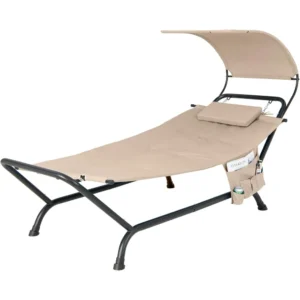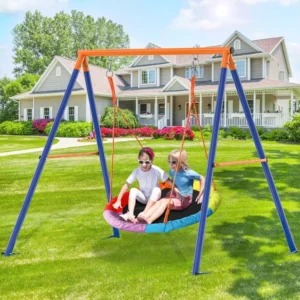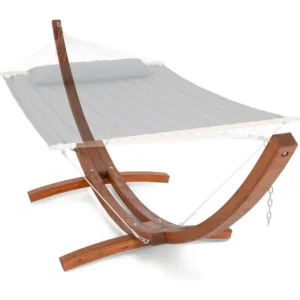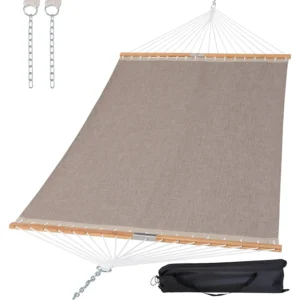What Makes Material Selection Critical for Folding Hammocks?
Folding hammocks represent a unique intersection of relaxation and engineering. Unlike traditional hammocks that remain permanently installed between trees or posts, folding hammocks incorporate a collapsible stand and portable fabric system designed to set up quickly and pack away with ease. This distinctive design creates specific material requirements that directly impact your overall experience.
The materials used in folding hammocks determine:
- How much weight they can support (typically between 250-550 pounds)
- How easily you can transport them (most quality folding hammocks weigh 7-15 pounds)
- How long they’ll last through regular use and weather exposure
- How comfortable they feel during extended relaxation sessions
Finding the perfect balance between strength and lightweight properties is particularly challenging for folding designs. Too heavy, and your portable hammock becomes cumbersome to move. Too light, and you risk compromising stability and durability.
This guide will help you understand the critical materials that make exceptional folding hammocks possible, whether you’re evaluating options for purchase or considering a DIY project. The right materials transform a simple folding hammock from merely functional to truly exceptional, enhancing both your indoor outdoor hammock placement options and overall satisfaction.
Our curated selection of folding hammock sets demonstrates how premium materials can make a substantial difference in performance and comfort.
Essential Properties for Folding Hammock Materials
When evaluating materials for folding hammocks, certain properties stand out as particularly important for ensuring performance, comfort, and longevity.
Strength-to-weight ratio:
– The most fundamental consideration in portable designs
– Measures how much weight a material can support relative to its own weight
– Enables lightweight frames to support substantial weight (a well-designed 2-pound aluminum frame can support 300+ pounds)
Weather resistance:
– UV protection to prevent fabric fading and degradation
– Moisture resistance to prevent mold and mildew growth
– Rust and corrosion prevention for metal components
Durability factors:
– Tear resistance, particularly important for fabric components
– Abrasion resistance for areas with regular friction
– Fatigue resistance, especially for parts that regularly fold and unfold
Compactness:
– Material thickness affects how tightly components can fold
– Flexibility determines how small the system can become when packed
– Influences overall portability and storage requirements
Comfort considerations:
– Texture against skin for direct-contact materials
– Breathability to prevent excessive heat buildup
– Body contouring properties that enhance relaxation
Understanding these properties helps explain why certain materials consistently appear in the strongest materials for hammock stands and provides context for the choices manufacturers make when designing portable hammocks with stands.
Premium Stand Materials for Superior Support
The stand is quite literally the backbone of any folding hammock system, providing the structural integrity needed for safe, comfortable use. Premium materials make a substantial difference in performance, durability, and user experience.
Aircraft-grade aluminum (6061-T6):
– Features an exceptional strength-to-weight ratio
– Naturally corrosion resistant without additional treatments
– Typically supports up to 450 pounds while weighing 30-40% less than steel alternatives
– Offers superior portability for frequent travelers and campers
Powder-coated steel:
– Provides maximum strength and stability
– Powder coating adds significant rust and corrosion protection
– Heavier than aluminum but often less expensive
– Ideal for situations where ultimate stability is more important than portability
Hardwoods (teak, oak):
– Offers natural aesthetic appeal for home and garden settings
– Requires proper weather treatment to maintain longevity
– Generally heavier and less portable than metal options
– Provides exceptional stability when properly constructed
The engineering principles behind stand materials significantly impact overall performance and stability. Understanding these principles, as explained in our guide on A-frame hammock stand engineering strength, can help you make an informed decision about which material best suits your needs.
Fabric Materials for Comfort and Durability
The fabric component of a folding hammock directly contacts your body, making its material composition critical to both comfort and support. Premium hammocks utilize specialized fabrics designed for specific performance characteristics.
Premium synthetic fabrics:
– Ripstop nylon: Features a reinforcement technique using a special crosshatch pattern that prevents tears from spreading. 210T ripstop nylon provides an optimal balance of strength and lightweight properties.
– Textilene: A PVC-coated polyester mesh that offers excellent durability and weather resistance while allowing airflow.
– High-denier polyester: More substantial polyester fabrics (200D to 600D) offer increased durability while maintaining reasonable weight. Higher denier numbers indicate stronger, more abrasion-resistant fabric.
Weather-resistant treatments:
– UV inhibitors extend fabric life by preventing sun damage
– Water-repellent coatings keep moisture from saturating the material
– Antimicrobial treatments prevent mold and mildew growth in humid environments
Breathability considerations:
– Open-weave designs allow air circulation in hot weather
– Moisture-wicking properties help maintain comfort in humid conditions
– Heat-reflective fabrics minimize heat absorption on sunny days
Structural reinforcement:
– Double or triple stitching at weight-bearing points
– Reinforced edge binding to prevent stretching
– Strategic bar-tacking at high-stress connection points
These fabric considerations are particularly important for lightweight hammock sets, where material efficiency directly impacts both comfort and portability.

Innovative Hardware Components for Folding Mechanisms
The hardware that enables a hammock to fold and deploy represents some of the most sophisticated engineering in the entire system. These components must be simultaneously strong, reliable, and compact.
High-grade fasteners:
– Stainless steel fasteners: Offer superior corrosion resistance and strength, ideal for outdoor use
– Zinc-plated options: Provide good corrosion resistance at a lower cost point
– Self-locking designs: Prevent loosening during regular use and movement
Quick-release mechanisms:
– Spring-loaded pins allow rapid deployment and collapse
– High-carbon steel springs provide consistent tension over thousands of cycles
– Ergonomic designs minimize pinch points and enhance safety
Tension systems:
– Marine-grade stainless steel springs rated for repetitive stress
– Elastic components with UV-resistant properties
– Specialized tensioning hardware for adjustable comfort settings
Connection points:
– Reinforced grommets distribute stress across fabric
– Forged D-rings and carabiners exceed minimum strength requirements
– Marine-grade stainless steel carabiners rated for 1,200+ pounds of force
Anti-slip materials:
– Rubberized feet prevent movement on smooth surfaces
– Textured contact points improve grip in various conditions
– Stability-enhancing features that prevent rocking or shifting
The sophisticated engineering behind these components is what makes the concept to unfold your adventure with folding hammocks a practical reality, transforming complex hardware into simple, user-friendly relaxation systems.
The Science of Weight Distribution in Material Design
The engineering behind folding hammocks involves sophisticated principles of physics and materials science, particularly regarding how weight is distributed throughout the system.
Engineering principles behind material structure:
– Material thickness varies strategically throughout the frame
– Reinforcement occurs at critical load-bearing junctions
– Triangulated support structures maximize strength while minimizing material use
Stress point analysis:
– High-stress zones receive additional material reinforcement
– Connection points feature multiple redundant support elements
– Stress-distributing designs spread load across larger areas
Material composition effects:
– Aluminum alloys balance flexibility and rigidity
– Carbon content in steel determines overall strength
– Fabric weave patterns optimize strength in the primary tension direction
Rigidity vs. flexibility:
– Strategic flex points absorb movement and shock
– Rigid sections maintain overall structural integrity
– The interplay between rigid and flexible elements creates stable comfort
Weight distribution principles:
– Center of gravity calculations determine optimal support positioning
– Balanced loading prevents tipping or uneven wear
– Even tension distribution extends material life
These principles are evident in our quick-setup hammock sets, where sophisticated engineering enables remarkable stability despite the portable nature of the products.
Weather-Resistant Materials for Outdoor Durability
Outdoor exposure presents significant challenges for hammock materials. Premium folding hammocks incorporate specialized weather-resistant properties to ensure longevity and performance in various conditions.
| Material Type | UV Resistance | Water Resistance | Temperature Range | Corrosion Resistance |
|---|---|---|---|---|
| Aircraft Aluminum | Excellent | Excellent | -30°F to 200°F | Excellent |
| Powder-Coated Steel | Very Good | Very Good | -40°F to 180°F | Good |
| Ripstop Nylon | Good (with treatment) | Good (with DWR) | 0°F to 160°F | N/A |
| Textilene | Excellent | Excellent | -20°F to 180°F | N/A |
| Hardwoods | Poor (needs sealing) | Poor (needs sealing) | 20°F to 140°F | N/A |
UV-resistant technologies:
– UV inhibitors bonded at the molecular level
– Fade-resistant dyes and pigments
– Protective coatings that block harmful rays
Rust and corrosion prevention:
– Anodized aluminum resists oxidation
– Powder-coating creates a protective barrier on steel
– Marine-grade stainless steel components for maximum protection
Water-resistance options:
– DWR (Durable Water Repellent) treatments cause water to bead and roll off
– Fully waterproof materials for extreme conditions
– Quick-drying fabrics minimize moisture retention
For more detailed information on these protective features, explore our comprehensive guide to waterproof materials for hammock protection and learn about whether it’s okay to leave your hammock outside.
Camping Hammock Sets with Bug Net, Ultralight Camping Hammock Sets
$139.72 Select options This product has multiple variants. The options may be chosen on the product pageClassic Wooden Stand Hammock Sets, Heavy Duty Hammock Sets
$1,061.68 Select options This product has multiple variants. The options may be chosen on the product pageHammock Sets with Canopy, Heavy Duty Hammock Sets
$286.31 Select options This product has multiple variants. The options may be chosen on the product pageFolding Hammock Sets, Quick Setup Hammock Sets
Price range: $305.52 through $583.27 Select options This product has multiple variants. The options may be chosen on the product pageHeavy Duty Hammock Sets, Wooden Arc Stand Hammock Sets
$878.66 Select options This product has multiple variants. The options may be chosen on the product page
Material Care and Maintenance for Longevity
Proper maintenance significantly extends the life of your hammock materials, preserving their strength, appearance, and functionality over many years of use.
Frame material care:
– Aluminum frames: Rinse with fresh water after beach or pool use; occasional mild soap cleaning
– Steel frames: Check powder coating for chips; touch up promptly to prevent rust
– Wooden frames: Apply sealant annually; keep out of prolonged moisture when possible
Fabric maintenance:
– Remove debris regularly to prevent staining
– Clean with mild soap and water, avoiding harsh chemicals
– Allow to dry completely before storage to prevent mildew
– Protect from prolonged, direct sunlight when not in use
Hardware maintenance:
– Lubricate moving parts with silicone-based lubricants
– Check fasteners regularly and tighten as needed
– Clean sand or dirt from folding mechanisms
– Inspect for early signs of corrosion or wear
Storage recommendations:
– Store completely dry to prevent mildew and material degradation
– Use included storage bags to protect from dust and UV exposure
– Store in climate-controlled areas when possible for maximum longevity
– Avoid compressing fabric components for extended periods
These care guidelines are particularly important for heavy-duty hammock sets where the investment in premium materials deserves protection through proper maintenance.

Materials for Different Usage Environments
Different environments place unique demands on hammock materials, requiring specific properties to ensure optimal performance and longevity.
Beach environments:
– Salt-air resistant aluminum or marine-grade stainless steel
– UV-stabilized fabrics to prevent degradation
– Sand-resistant mechanisms that won’t jam or grind
– Quick-drying materials to prevent mildew
Forest/camping settings:
– Lightweight yet durable materials for easier transport
– Tear-resistant fabrics to handle proximity to branches and rough surfaces
– Weather-resistant components for unexpected rain
– Neutral colors that blend with natural surroundings
Home/patio usage:
– Balance of aesthetics and durability
– Weather-resistant materials for semi-permanent outdoor placement
– Fade-resistant fabrics to maintain appearance
– Stable base materials to prevent tipping on decks or patios
Travel requirements:
– Ultra-compact materials designed for minimal packed size
– Lightweight components prioritized for carry convenience
– Quick-assembly materials that don’t require tools
– Durable fabrics and frames that withstand frequent handling
Understanding these environmental factors is essential for proper hammock installation requirements and safety in various settings.
How Quality Materials Enhance Your Relaxation Experience
The materials in your folding hammock do more than provide physical support—they fundamentally shape your entire relaxation experience.
When you settle into a hammock made with premium materials, you immediately sense the difference. The fabric cradles your body with just the right amount of give, supporting without sagging. The stand remains rock-solid, eliminating the subtle anxiety that comes from feeling unstable or unsupported. This security allows your mind to truly let go.
Quality materials work silently in the background of your experience. The breathable yet strong fabrics keep you cool while supporting your weight. The precisely engineered frame components distribute weight evenly, eliminating pressure points. The weather-resistant treatments mean you’re not constantly checking the sky for approaching clouds.
This peace of mind—knowing that your hammock’s materials are reliable, durable, and thoughtfully selected—allows for deeper relaxation. After all, true relaxation comes when concerns fade away, and quality materials help make that possible.
For maximum enjoyment, consider how your perfect hammock placement at home or garden can complement these material benefits.
Important Safety Considerations in Material Selection
Safety should never be compromised when selecting hammock materials, as the consequences of failure can be significant.
Material certification standards:
– Look for materials that meet ASTM (American Society for Testing and Materials) standards
– ISO certifications indicate adherence to international quality protocols
– Certified weight capacities include substantial safety margins
Weight capacity considerations:
– Quality manufacturers build in 20-25% safety margins above stated capacity
– Dynamic loading (movement) requires stronger materials than static loading
– Combined material systems should exceed the strength of any single component
Quality control indicators:
– Consistent stitching with no loose threads
– Even finishes without bubbles or peeling
– Smooth operation of all moving parts
– Uniform weave patterns in fabric components
Warning signs of substandard materials:
– Visible defects like scratches or dents in metal components
– Chemical odors that don’t dissipate after unboxing
– Inconsistent coloration or texture
– Rough edges or burrs on metal parts
Always follow manufacturer guidelines regarding setup and use, as improper assembly can compromise even the strongest materials. For complete information on using materials safely, refer to our indoor outdoor hammock safety guide.
Questions About Folding Hammock Materials
Can folding hammock materials truly support the same weight as traditional hammocks?
Yes, premium folding hammocks use advanced materials and engineering to support equivalent weights (300-550 pounds). The key difference is in the design approach rather than weight capacity. Quality folding stands distribute weight more efficiently through strategic material placement and advanced joint construction.
What materials provide the best balance of strength and portability?
Aircraft-grade aluminum (6061-T6) currently offers the optimal balance. This material delivers approximately 70-80% of steel’s strength while weighing roughly one-third as much. When combined with strategic reinforcement at stress points, it creates systems that are both lightweight and exceptionally strong.
How often should different materials be replaced or inspected?
Fabric components should be inspected before each use for signs of tearing or UV degradation. Metal frames should be checked seasonally for corrosion, loose fasteners, or bend points. With proper care, premium materials can last 5-10 years for frames and 3-5 years for regularly used fabric components.
Are natural or synthetic materials better for folding hammock designs?
Synthetic materials generally perform better in folding designs due to their consistency, weather resistance, and strength-to-weight ratio. Natural materials like cotton and wood offer aesthetic and tactile benefits but typically require more maintenance and offer less portability.
What are the most common material failure points in folding hammocks?
Connection points between different materials (such as fabric-to-frame attachments) are the most vulnerable. After this, moving parts in folding mechanisms experience the most stress. Premium designs reinforce these areas with higher-grade materials and redundant support systems.
For more detailed guidance on selecting appropriate materials, check out our expert advice on choosing the perfect material for lightweight outdoor hammocks.
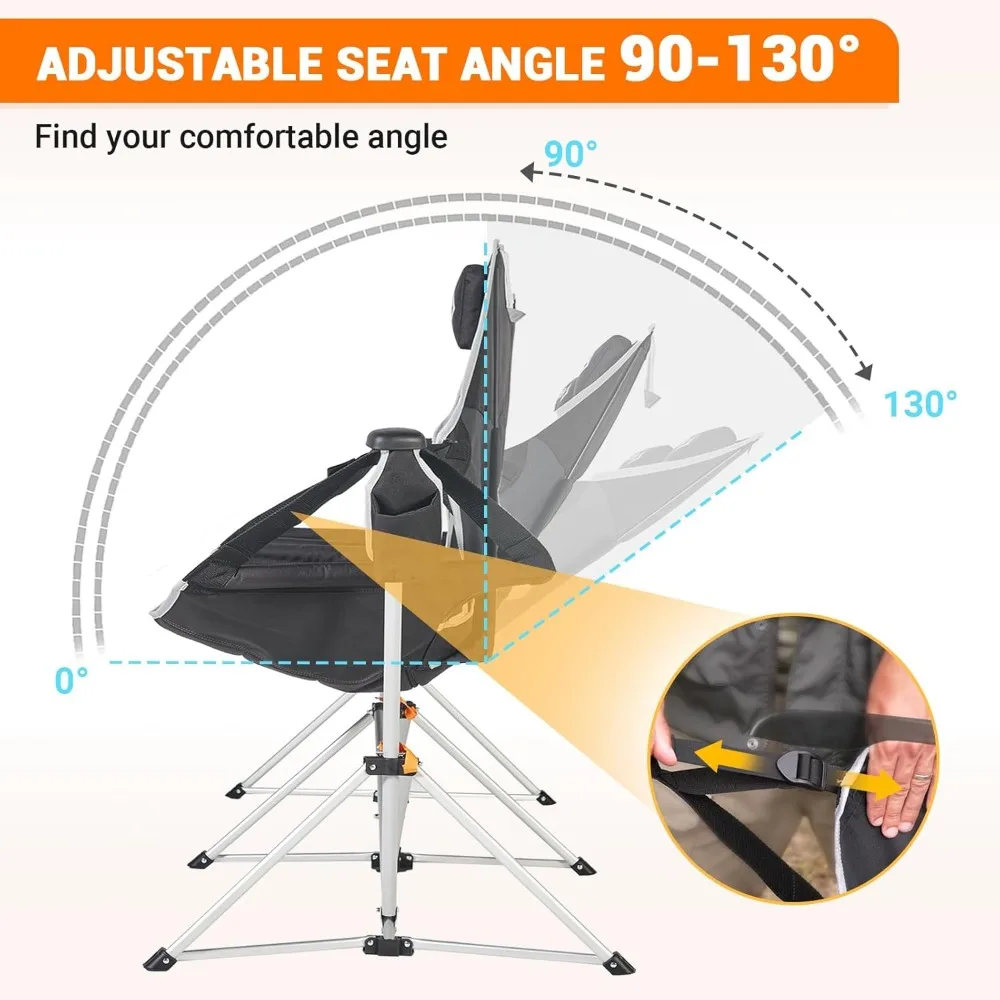
Shopping Guide: How to Evaluate Material Quality Before Purchasing
When shopping for a folding hammock, use these guidelines to assess material quality:
Visual quality indicators:
– Even stitching with reinforcement at stress points
– Consistent coloration and finish on all components
– Smooth, burr-free edges on metal parts
– Clear labeling of material types and specifications
Critical specifications to verify:
– Specific material types (not just “metal” but “6061-T6 aluminum”)
– Actual weight capacity (not just “heavy-duty”)
– Fabric denier or thickness measurements
– Hardware grade (commercial vs. industrial grade)
Questions for manufacturers:
– “What type of aluminum/steel is used in the frame?”
– “What is the specific denier or thickness of the fabric?”
– “Are the fabrics treated for UV and water resistance?”
– “What testing protocols do your materials undergo?”
Red flags suggesting inferior materials:
– Vague material descriptions (“high-quality metal”)
– Unusually light weight relative to claimed capacity
– Significantly lower pricing compared to similar products
– No mention of specific material grades or types
Remember that value extends beyond price—a slightly more expensive hammock made with superior materials often provides better long-term value through extended durability and enhanced performance.
For examples of how materials influence assembly ease, explore our collection of perfect quick-assembly folding hammocks and ultralight camping hammock sets.
Conclusion: Investing in Quality Materials for Lasting Enjoyment
The materials used in folding hammocks directly determine not just how long they last, but how much enjoyment they provide throughout their lifetime. From the aerospace-grade aluminum that makes portability possible to the specialized fabrics that cradle your body in comfort, each material plays a crucial role in the overall experience.
Investing in quality materials pays dividends through years of reliable use, consistent comfort, and worry-free relaxation. The best folding hammocks achieve a perfect balance—strong enough to support you securely, light enough to move easily, and durable enough to withstand the elements.
Whether you prioritize ultra-portability for adventures far from home or maximum comfort for backyard relaxation, understanding how materials contribute to these qualities helps you make choices aligned with your specific needs and preferences.
The right materials transform a simple hammock into an enduring source of relaxation and rejuvenation—a worthwhile investment in your comfort and well-being for years to come.

